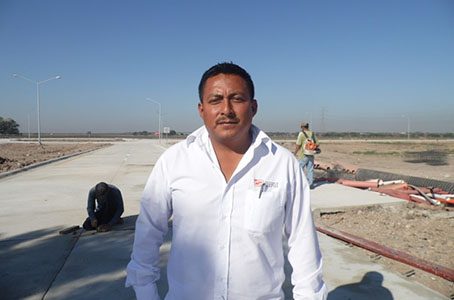Interview: Obed Fuentes Martínez Manager of Colados Culiacán and ex-agricultural worker at Agricola Belher

Architect by profession and a person who demonstrates that with tenacity we can achieve each of our goals.
Originally from Salinas Cruz, Oaxaca, Obed migrated to Culiacán 24 years ago, he and his family joined Agrícola Belher, where his parents found employment opportunities.
Today Obed shares what were the main challenges he faced, his fears and the achievements he has achieved during his stay in Sinaloa.
- What was the reason your family migrated to Sinaloa?
The lack of work in Oaxaca. My dad was a bricklayer and it became very heavy work for him. One day he heard about the people who came to work in the fields of Sinaloa.
- What did your dad do in the country?
My dad was initially a crew chief, then he was three or four years as a butler. Then the person who brought us, the contractor, accommodated him in the warehouse where he worked most of the time. At the moment he is the porter of the office of Agrícola Belher; Despite his age does not give up.
- Did your mom also work in the field?
No, my mom was never a field person. She is very struggling and always looked for other ways to support the family: she cooked to assist other workers, prepared, and sold cakes, sold different things.
- What kind of work did you do in the field?
I went through every field work: planting tomato, planting, cutting, fumigating, packing, and even participated in a company safety program and also worked in the DICONSA (Conasupo Distributors) store.
- Where did you study?
I arrived at the Lo de Beltran camp and studied fifth grade at the school there. Then I returned to Oaxaca where I finished elementary school. My parents returned and I stayed two years studying there. When I returned, I finished high school in Villa Angel Flores, La Palma.
To study high school, Mr. Dora Ochoa (Manager of Human Resources of Agricultural Belher) I support. She took me to take the exam to enroll in the Central High School of the Autonomous University of Sinaloa (UAS), but since I always had the unease about the construction, maybe because my dad was a mason, I also did the exam in the Center for Studies Technological, Industrial and Services (CETIS) because he had a technical career under construction and was where he studied.
Later I signed up in the career of architecture in the Universidad Autonoma de Sinaloa.
- How did you do to pay for your studies?
He worked. When I lived in the countryside, I worked in the afternoons in the store and in the tortilla shop at Agrícola Belher. Later I found some relatives in Culiacan and I could rent a little house, that’s when I started working as a cashier in supermarkets and a waiter in party rooms; But had difficulties with the schedule.
Mrs. Dora Ochoa then contracted me to work on the packaging. She always supported me so that the schedule would accommodate me and I had the opportunity to continue studying.
Sometimes I would leave at 12 or 1 am, rest for a while, get up and take a truck to go to Culiacan to the university from 7 am to 12 pm.
Return to the packaging when the safety project was carried out, when the whole boom began on this topic, and I had to participate in the first user manual of the National Service of Health, Food Safety, and Agro-Food Quality (SENASICA). I will study and implement it in the field.
While living in the country, I could buy myself a computer and a stretcher with the help of my father. Dona Dora assigned me a room in the lodge for me alone and conditioned it; Which was very complicated because the housing is for the workers.
There were times when my economic situation repressed me. Especially in the race because although architecture is not an expensive race, people are buying more expensive materials; Then if you are not at that level it is difficult to match.
Thank God I always had the support of my parents, morally and economically.
- Do your parents still live in the country?
My mother was tough to leave the field, for her the field was like a bubble in which I knew everyone. With effort my father managed to buy a plot of land in La Palma and when I left the university I began to fix it.
My mom had the idea that the expenses would increase, but the comfort of being at home does not compare. At the end of the day when you live in the country, nothing is yours, it’s a very small place and you can not buy your things.
I recently bought the land next door and I have been fixing my house little by little.
- Could you tell us a little bit about the places where you worked?
My first job was obtained while in college, thanks to the contact of a teacher, I worked with the Architect Amado Palazuelos in Obregón, Sonora, building the premises of the Bambú restaurant in that city. After this opportunity, I was part of the team of a construction company called Proseco.
A year later I participated in a project with a company called Dynamics, in Guadalajara. The project consisted of something very like what is done here in the fields with the migrant people.
Once my first child was born, I returned to Culiacan and it was when I supported Agrícola Belher Belher with the safety project. Six months later I was hired at Coppel and I was building stores in different cities: Puebla, Michoacán, etc.
What are you doing now?
I am Manager of Coladas Culiacán, the company really is dedicated to everything that is cast of pavements, slabs, etc.
- Do you think that your life would have been the same if you had stayed in Oaxaca?
Don’t. There I probably would not have studied and enlisted in the naval army or I would have settled in Petróleos Mexicanos (PEMEX), which is what people do there.
I can say that I still have not achieved everything I have in mind, I am currently teaming up with friends and we are organizing a rock board business. That is my goal, to have a company of my own and to instill good values and good things for my children.
- Anything else you want to add?
I want to thank you for taking me in mind and hope that your association can support more children.
Now it surprises me how there are trucks that take many children to study, when before there were only three. It is there is much support, from scholarships to programs that support with 3-5 thousand pesos to the families of day laborers.


